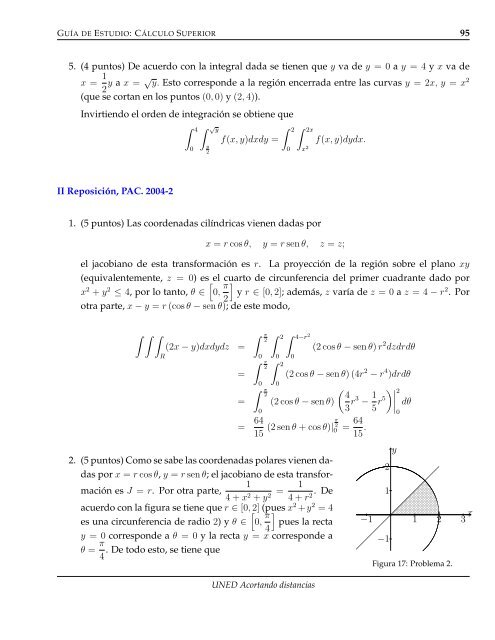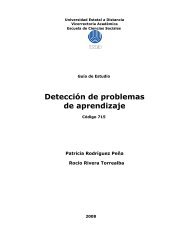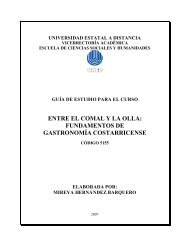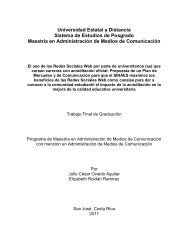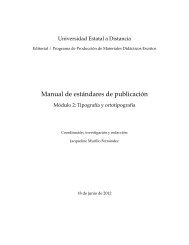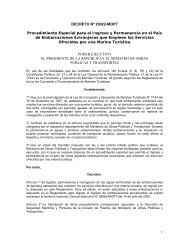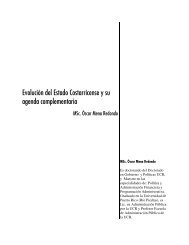GE3011 Cálculo Superior - Repositorio de la Universidad Estatal a ...
GE3011 Cálculo Superior - Repositorio de la Universidad Estatal a ...
GE3011 Cálculo Superior - Repositorio de la Universidad Estatal a ...
You also want an ePaper? Increase the reach of your titles
YUMPU automatically turns print PDFs into web optimized ePapers that Google loves.
GUÍA DE ESTUDIO: CÁLCULO SUPERIOR 95<br />
5. (4 puntos) De acuerdo con <strong>la</strong> integral dada se tienen que y va <strong>de</strong> y = 0 a y = 4 y x va <strong>de</strong><br />
x = 1<br />
2 y a x = √ y. Esto correspon<strong>de</strong> a <strong>la</strong> región encerrada entre <strong>la</strong>s curvas y = 2x, y = x 2<br />
(que se cortan en los puntos (0, 0) y (2, 4)).<br />
Invirtiendo el or<strong>de</strong>n <strong>de</strong> integración se obtiene que<br />
II Reposición, PAC. 2004-2<br />
4 √<br />
y<br />
0<br />
y<br />
2<br />
f(x, y)dxdy =<br />
2 2x<br />
1. (5 puntos) Las coor<strong>de</strong>nadas cilíndricas vienen dadas por<br />
0<br />
x 2<br />
f(x, y)dydx.<br />
x = r cos θ, y = r sen θ, z = z;<br />
el jacobiano <strong>de</strong> esta transformación es r. La proyección <strong>de</strong> <strong>la</strong> región sobre el p<strong>la</strong>no xy<br />
(equivalentemente, z = 0) es el cuarto <strong>de</strong> circunferencia <strong>de</strong>l primer cuadrante dado por<br />
x2 + y2 <br />
≤ 4, por lo tanto, θ ∈ 0, π<br />
<br />
y r ∈ [0, 2]; a<strong>de</strong>más, z varía <strong>de</strong> z = 0 a z = 4 − r<br />
2<br />
2 . Por<br />
otra parte, x − y = r (cos θ − sen θ); <strong>de</strong> este modo,<br />
<br />
R<br />
(2x − y)dxdydz =<br />
=<br />
=<br />
π<br />
2<br />
0 0<br />
π 2 2<br />
0<br />
π<br />
2<br />
0<br />
= 64<br />
15<br />
2 4−r2 0<br />
0<br />
(2 cos θ − sen θ) r 2 dzdrdθ<br />
(2 cos θ − sen θ) (4r 2 − r 4 )drdθ<br />
(2 cos θ − sen θ)<br />
(2 sen θ + cos θ)| π<br />
2<br />
0 = 64<br />
15 .<br />
2. (5 puntos) Como se sabe <strong>la</strong>s coor<strong>de</strong>nadas po<strong>la</strong>res vienen da-<br />
das por x = r cos θ, y = r sen θ; el jacobiano <strong>de</strong> esta transfor-<br />
1<br />
mación es J = r. Por otra parte,<br />
4 + x2 1<br />
= . De<br />
+ y2 4 + r2 acuerdo con <strong>la</strong> figura se tiene que r ∈ [0, 2] (pues x2 + y2 <br />
= 4<br />
es una circunferencia <strong>de</strong> radio 2) y θ ∈ 0, π<br />
<br />
pues <strong>la</strong> recta<br />
4<br />
y = 0 correspon<strong>de</strong> a θ = 0 y <strong>la</strong> recta y = x correspon<strong>de</strong> a<br />
θ = π<br />
. De todo esto, se tiene que<br />
4<br />
UNED Acortando distancias<br />
<br />
4<br />
3 r3 − 1<br />
5 r5<br />
2 <br />
dθ<br />
0<br />
2<br />
1<br />
.<br />
.<br />
.<br />
.<br />
.<br />
.<br />
.<br />
.<br />
.<br />
.<br />
.<br />
.<br />
.<br />
.<br />
.<br />
.<br />
.<br />
.<br />
.<br />
.<br />
. .<br />
... .<br />
.. . ... . .<br />
.<br />
.<br />
.<br />
.<br />
.<br />
.<br />
.<br />
.<br />
.<br />
.<br />
.<br />
.<br />
.<br />
.<br />
.<br />
.<br />
.<br />
.<br />
. . . . .<br />
.<br />
.<br />
. .<br />
. .<br />
x.<br />
.<br />
−1 1 2 3<br />
−1<br />
y<br />
Figura 17: Problema 2.<br />
.<br />
.


